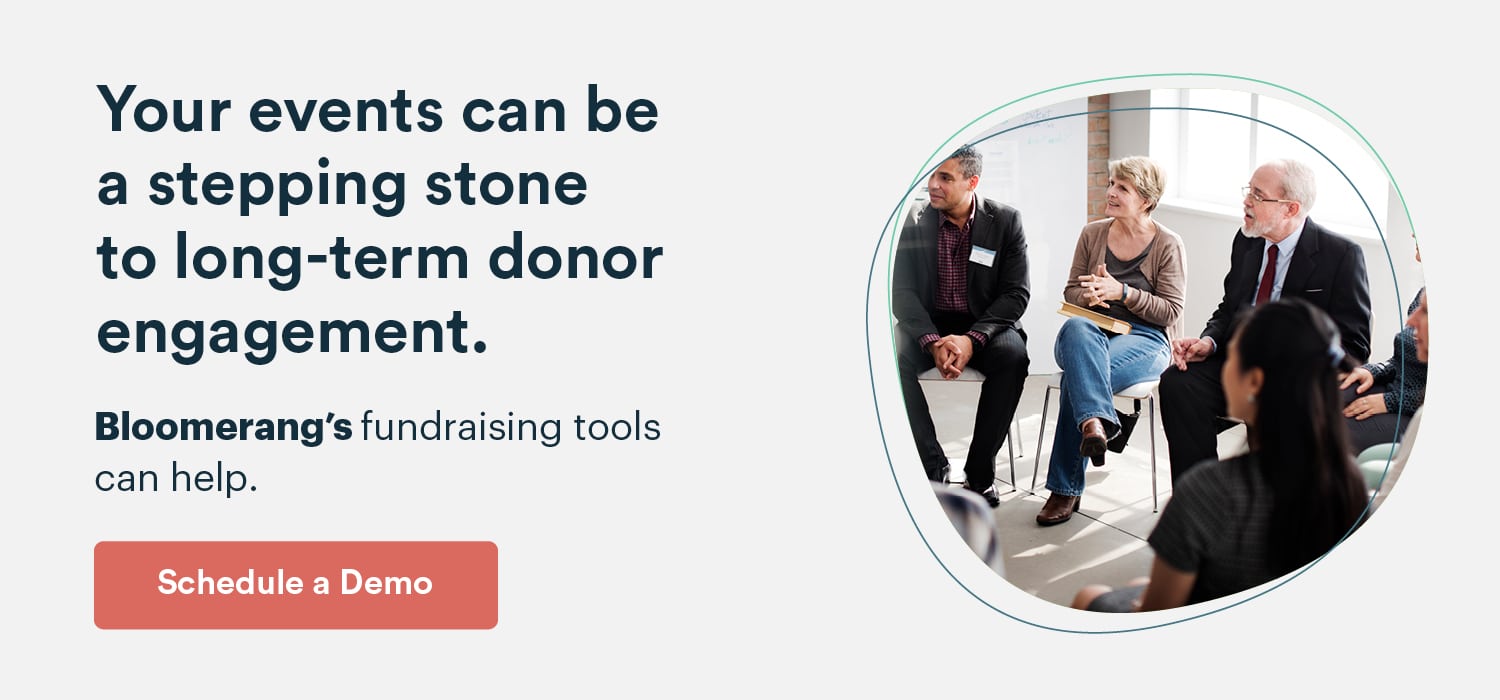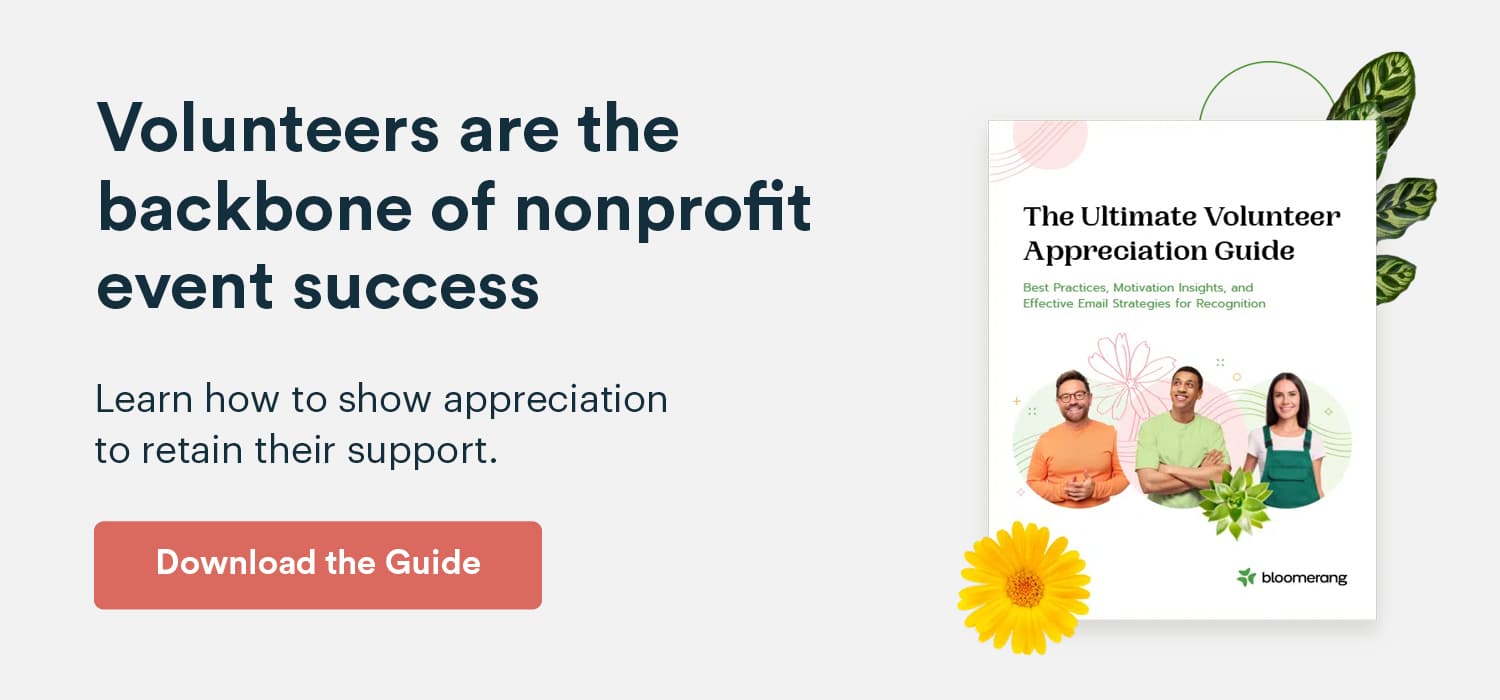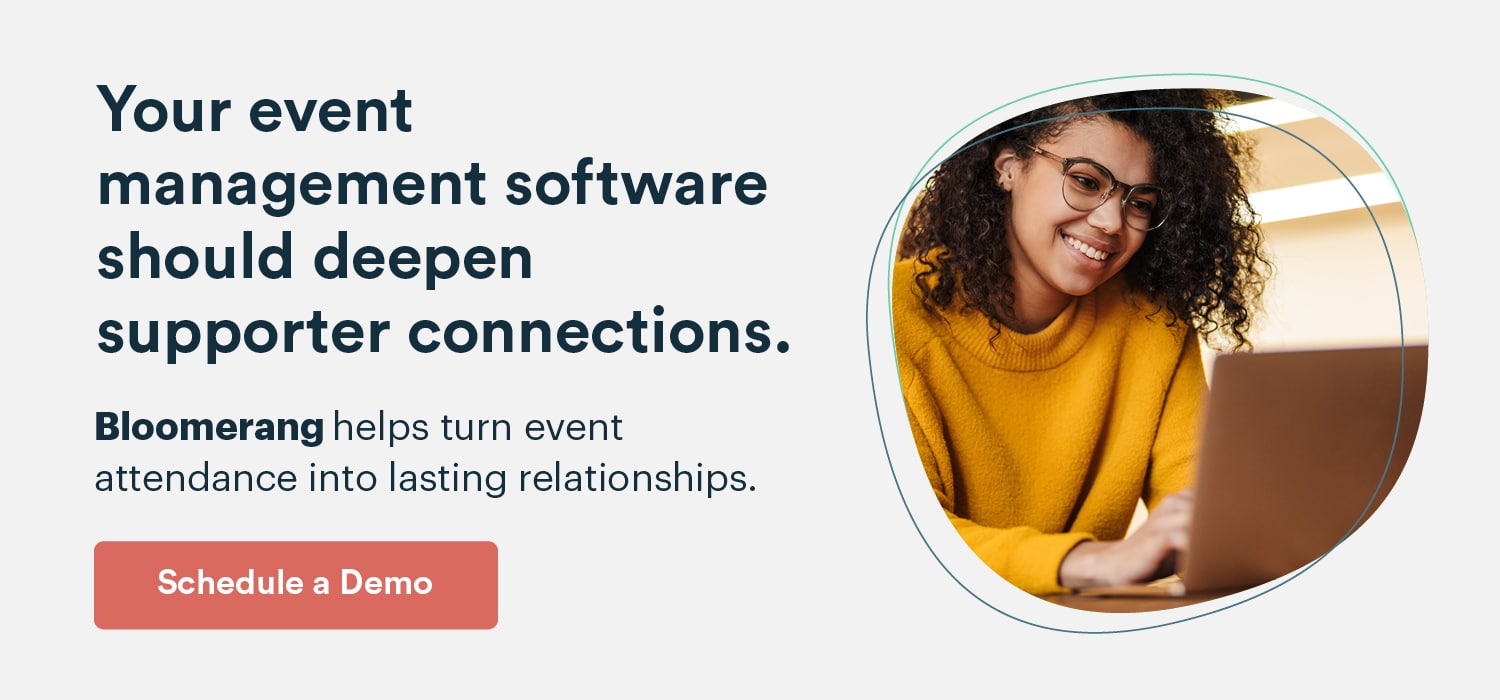Nonprofit Event Management: Checklist and Tips for Success

Fundraising events bring nonprofit missions to life for supporters. Donors, volunteers, and other community members can interact with one another and your nonprofit’s staff, meet community members impacted by your mission, and work together to raise funds for your worthy cause.
Plus, nonprofit supporters enjoy fundraising events. 56% of nonprofit donors regularly attend fundraising events, demonstrating enthusiasm for these experiences.
The most successful fundraising events are carefully planned, leaving no details up to chance. This guide explores nonprofit event management tips and best practices to help your organization plan its best event yet. Let’s get started by defining the event management process.
What is nonprofit event management?
Nonprofit event management involves the steps your nonprofit takes to ensure your events go off without a hitch.
Event management for nonprofits involves:
- Selling tickets and gathering RSVPs
- Sending important updates about the function to confirmed attendees
- Collecting donations before, during, and after the event
- Tracking attendee information
- Validating tickets at the time of the event
- Engaging with attendees during the event to build relationships
- Following up with attendees to thank them for their participation and share event results
A clear event plan is essential because these experiences can give momentum to your fundraising efforts. Almost 55% of Americans say that events spark feelings of connection. When supporters feel connected to your mission, they’ll be much more likely to continue giving over time.
Nonprofit event management checklist
How can your nonprofit successfully plan an event that sparks generosity, mission awareness, and long-term engagement? You’ll need to take specific steps so that nothing falls through the cracks. Use this event planning checklist to stay organized and on task:
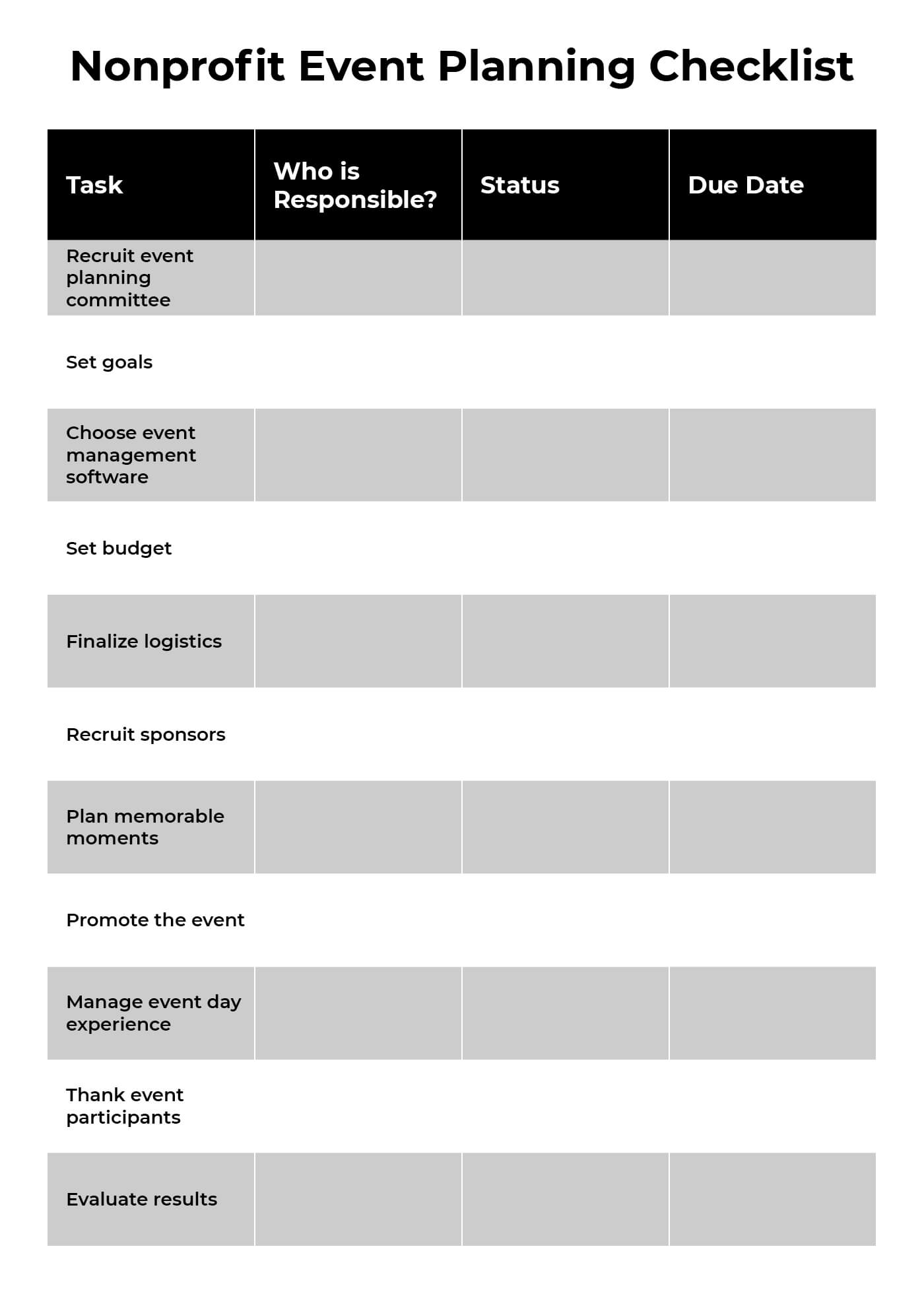
1. Recruit an event-planning committee.
The first thing you need to do when planning an event is recruit a strong team who can manage every aspect of the planning process. These individuals should be passionate about your mission, knowledgeable about your fundraising goals, and excited about bringing your event to life.
Involve a variety of stakeholders, including:
- Staff members. Staff members have the most context about your nonprofit’s budget and fundraising goals. They can provide experience from hosting past events and make recommendations based on what worked and what didn’t.
- Board members. Board members can play a significant role in recruiting event attendees, especially major donors. They can promote your event to a wider audience and provide a first-hand account of what it’s like to support your organization.
- Volunteers. Volunteers can help manage all the on-the-ground logistics your event needs to run smoothly. This could include everything from checking attendees in to managing parking to selling merchandise at your event.
Each of these committee members will play a unique role in the planning and execution of your events. Put out a request for volunteers using your email platforms, and reach out personally to individuals you think would be interested and a good fit for the role.
2. Set event goals.
Giving your event a clear, defining purpose and goal will help guide the rest of the planning process. Here are a few examples of types of goals you might set, depending on the purpose of your event:
- Fundraising goals: If you’re hosting a fundraising event, set ambitious but achievable goals of how much you’d like to raise in total or through peer-to-peer donations.
- Donor engagement goals: Along with financial goals, donor engagement targets can help you prioritize donor experience.Donor engagement goals could include a specific number of new donors acquired or a target number of donors with whom your staff members will have personal conversations.
- Advocacy goals: If you’re hosting an advocacy event to raise awareness and support for a specific issue, you can set goals for a certain number of attendees, petition signatures, or letters sent to representatives.
Make your goals as specific as possible. For example, don’t just aim to generally increase the number of new donors during your event—plan to recruit 150 new donors. Setting specific targets will give your event planning team a clear metric to work toward and measure success.
3. Use event management software for nonprofits.
Event management software, also known as fundraising event software, is an online fundraising tool to help organizations manage ticketing, RSVPs, online bids for auctions, and more.
Look for an event management tool with features like:
- Branded event pages and registration forms
- Ticket packages for individuals, sponsors, VIPs, etc.
- Custom fields to track event attendee information
- Donation tools embedded in the event registration page
- Social media and email promotion options
- Customizable dashboard for reports and analytics
In addition, we recommend taking elements such as user-friendliness, integrations, and technical support into consideration before choosing a new event management platform.

It’s especially effective to leverage an event management tool that integrates with your donor management system, like Bloomerang + Qgiv. This solution combines Qgiv’s fundraising and event management tools seamlessly with Bloomerang’s donor management software.
You can use this platform to easily track all attendee interactions and donations and automatically add them to their profiles in your constituent database. Then, leverage this information to personalize your supporter outreach to make it more engaging.
For example, perhaps you ask event attendees for their dietary needs on your event registration page. By noting these needs in their constituent profiles, you can send attendees follow-up emails so they can choose meal alternatives that fit their preferences. This level of personalization creates a better experience and shows attendees that you care about them as individuals.
4. Determine your budget.
Your budget will guide your event planning process, giving you clear parameters to work within. Figuring out your budget early on in the event management process helps you think realistically about where you can splurge and where you should rein in costs.
Follow these steps to finalize your budget:
- Assess costs. What is the anticipated cost of necessities like your venue, food and drinks, security, decor, marketing, and event technology? Leave wiggle room for unexpected expenses that could arise during the planning process.
- Consider your fundraising goal. How much do you need to raise at your event to cover costs and meet your fundraising goal? If the ultimate purpose of your event is to raise funds for your mission, keep that in mind as you balance costs and fundraising needs.
- Evaluate your corporate sponsorships and other event donations. How much do you anticipate earning from corporate donors and individual major donors? These donations can greatly offset costs and allow you to spend more in certain areas that make your event more appealing, like decor or entertainment.
Consider your event’s budget within the context of your other fundraising initiatives, such as digital campaigns or marketing outreach. Avoid spending your entire fundraising budget on one event, as you might need funding to host multiple events and campaigns throughout the year.
5. Plan event logistics.
After finalizing your budget, you can start planning your event’s logistics and determining how much you can spend on aspects like your venue and entertainment.
Determine the who, what, when, and where of your event by working through logistics like:
- Date and time. If you’re hosting an outdoor event, choose a date that typically has pleasant weather in your area.
- Venue. Select a venue large enough to accommodate your expected number of attendees. Have a backup venue ready in case of emergencies. This is especially important if your event is outside. If there are poor weather conditions, decide whether you’ll reschedule or move to another venue.
- Parking. Ensure there are enough parking spots available for attendees. If you’ll need offsite parking, see if you can rent shuttles to transport attendees from the parking lot to the main event area.
- Security. If you’re hosting a major event like a festival, concert, or fundraising 5K, you’ll need reliable security to keep everyone safe. Get quotes from local security firms to find a trustworthy partner that fits your budget.
- Food and drinks. Offering food and drink options is crucial to ensure attendees stay happy and energized throughout your event. Recruit local vendors, such as restaurants and food trucks, to sell food and refreshments at your event.
- Restrooms. Determine whether your venue has restrooms or if you’ll need to arrange for portable ones.
- Entertainment. Increase excitement surrounding your event by bringing in outside entertainment, such as a DJ, live band, comedian, or performance group.
Feature your event’s logistics prominently in marketing materials. Quickly seeing when and where your event will take place and what type of experience to expect will make it easier for supporters to determine whether they’re available on that day and interested in the experience.
6. Gather event sponsors.
As corporate social responsibility becomes more popular, increasingly more companies are contributing funds and resources to support nonprofits. In fact, corporations gave over $21 billion to nonprofits last year.
Corporate sponsors donate to nonprofit events in exchange for benefits like marketing exposure. Seek out corporate sponsors in your community who can support your event. Local businesses like restaurants, auto body shops, retailers, and banks are often more than willing to support charitable organizations in their community.
However, not every business can provide the same level of support. Offer different benefits for different sponsorship tiers based on price. For example, consider these benefits for small, mid-tier, and major corporate sponsors:
- Small corporate donors: Inclusion of their name and logo on marketing materials like your event’s flier
- Mid-tier corporate donors: Social media post shoutouts on your nonprofit’s Facebook and Instagram pages ahead of the event
- Major corporate donors: Naming rights, such as the ability to name your entire event or pavilions or tents within your event
Lay out your sponsorship tiers clearly in event promotional materials, like this example event sponsorship request letter:
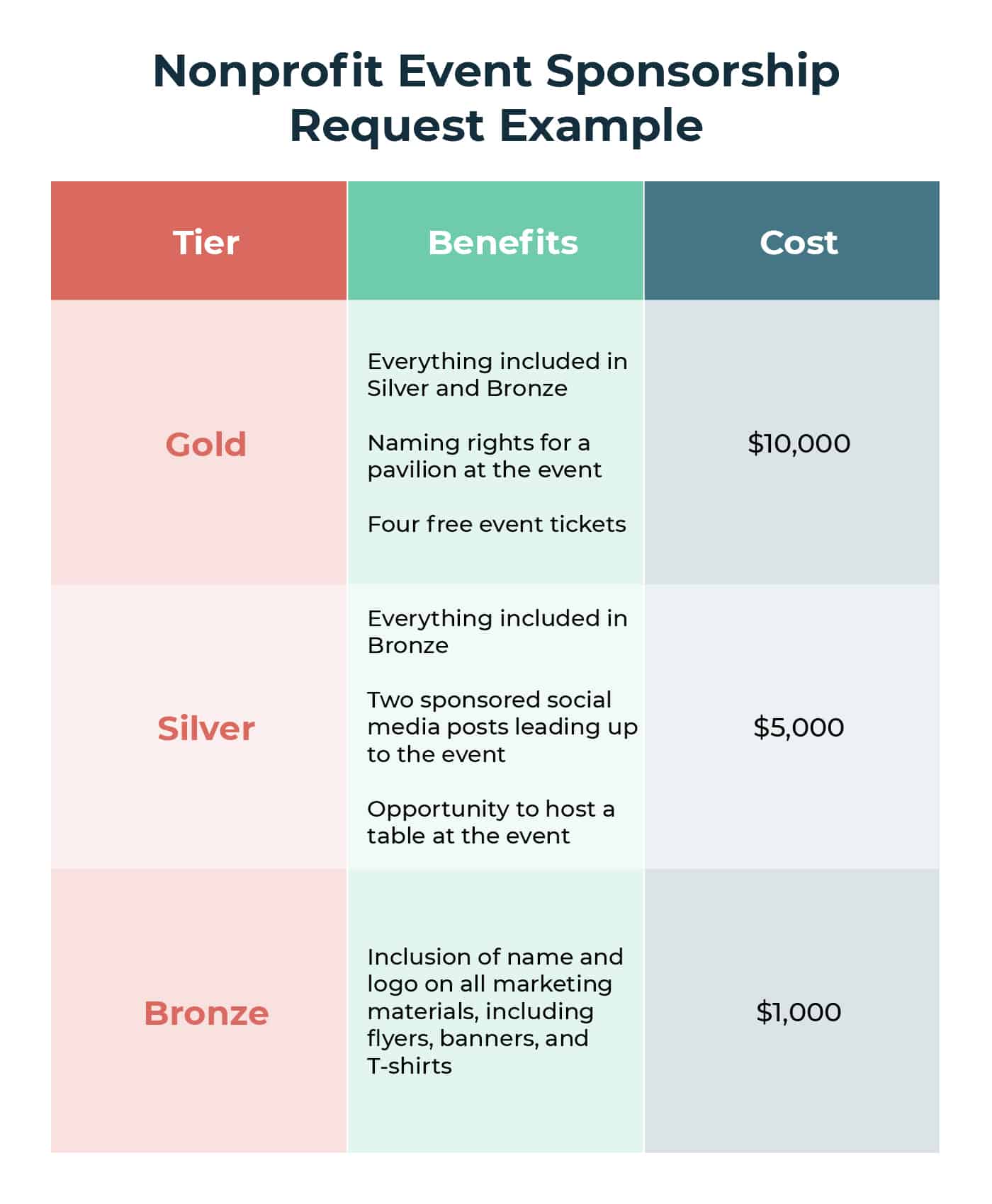
Some corporate donors may offer in-kind donations rather than monetary ones. These could include donated auction items, free event security, or event marketing support. Don’t discount these donations in your event planning process, as they can be incredibly helpful in cutting costs.
7. Plan memorable moments.
Making your event as unique and memorable as possible can inspire more engagement and donations from your audience. It can also encourage more supporters to attend your next opportunity.
Furthermore, adding unique elements to your event can encourage word-of-mouth marketing from attendees and increase your attendance levels for next time. According to the Global Trust in Advertising report, 92% of consumers around the world say they trust earned media, such as recommendations from friends and family, above all other forms of advertising.
Make your event one-of-a-kind with special moments like:
- Surprise guests or entertainers. Invite a surprise musician, comedian, or local celebrity to make an appearance at your event.
- Unique themes. Encourage attendees to dress up according to a unique theme, such as Disney villains or neon.
- A raffle with unique prizes. Hold a raffle at the end of your event. Be sure to offer enticing prizes like vacation packages or signed sports memorabilia.
- Prizes for top donors or peer-to-peer fundraisers. Host an award ceremony at the end of your event to recognize your top donors or peer-to-peer fundraisers who raised the most donations.
Think about it—if you attended a fundraising 5K on a Saturday, you might tell one or two coworkers about it on Monday morning at the office. But if you attended a Christmas-themed 5K that ended in a Polar Plunge, with a surprise appearance from Santa Claus and his reindeer, you might tell many more coworkers about your wacky experience.
When attendees feel like they attained something unique and valuable from attending your event, they’ll want to spread the word to family and friends. Don’t underestimate the power of FOMO (the fear of missing out) in your event management process!
8. Promote your event.
After spending time and energy planning an incredible experience, it’s time to promote your event to your audience.
Research shows that social media is the top channel event planners use to market their experiences, but it’s not the only platform at your disposal. In addition to social platforms like Facebook, Instagram, and LinkedIn, you can promote your event across channels such as:
- Flyers
- Word-of-mouth marketing
- Local press
- Text marketing
Use a graphic design service for nonprofits or free tools like Canva to design aesthetically pleasing, branded marketing materials.
A word of caution—some organizations have been using AI image generators to create event marketing materials, but these tools come with a lot of cons. Quality control issues, diversity and representation, and plagiarism are all potential concerns. If you choose to use AI-generated marketing materials, carefully edit and review them to ensure they’re on brand and make sense for your event’s needs.
9. Bring energy and enthusiasm to event day.
Planning your event is only half the battle—ensuring your event goes off without a hitch relies on your ability to manage challenges and inspire enthusiasm on event day.
Keep your event running smoothly on the big day by taking these proactive steps:
- Address issues promptly. Unexpected issues or challenges may arise on event day, but stay flexible and positive when addressing these roadblocks. Ensure all volunteers and staff members have clear roles so everyone knows who is responsible for different issues that may come up.
- Maintain open communication with your event planning team. Use walkie-talkies or instant messaging apps to maintain two-way communication between volunteers and your organization’s staff. This allows you to respond quickly if volunteers need more support in one area or supplies are running low in another area.
- Be fully present and engage with guests. As mentioned, events are an invaluable opportunity to engage with supporters one-on-one, form personal relationships, and ultimately boost retention. Take the opportunity to interact with volunteers, donors, and other community members, getting to know them and learning about their connection to your cause.
Encourage your volunteers and staff members to keep their energy high throughout the event. Thank team members who go above and beyond to fix issues or create positive attendee experiences.
10. Thank attendees and supporters.
Your event’s success will depend on the engagement and support of your donors, volunteers, staff members, corporate sponsors, and other community partners. After your event concludes, show your appreciation for these individuals through follow-up messages.
Make your gratitude known via:
- Thank-you emails and letters with information about your fundraising total and what the funds will be used for
- Appreciation videos featuring beneficiaries and leaders of your organization
- Social media and blog posts recapping your event and sharing photos from the experience
- Post-event surveys to ask supporters’ opinions about the event and receive suggestions for the next opportunity
Personalize your direct thank-you messages, like emails and letters, with supporters’ names and specific information about their involvement, such as their personal donation amount, number of volunteer hours contributed to the event, or in-kind donations they provided.
11. Evaluate event results.
Measuring your results will provide critical insights for the next time you plan an event. You can determine whether you allocated your volunteers, staff members, and budget effectively to drive a high return on investment (ROI).
Review event metrics such as:
- Number of RSVPs vs. actual attendees
- Total event revenue
- Total donations from specific sources, like individual donors and corporate sponsors
- Attendee and sponsor satisfaction rates (gathered from post-event surveys)
- ROI (total revenue minus total costs)
Compile data points into a clear narrative to share with your event-planning team. Identify what went well and where you can improve before your next event.
The Bottom Line
As you can see, nonprofit event management requires careful coordination between volunteers, staff members, and technology to bring a successful experience to life. The more time you spend thoughtfully planning your event, the more engagement and funding you can earn for your charitable mission.
Looking for more event planning resources? Start here:
- What Is Event Management Software For Nonprofits? Explore our guide to 20+ event management software tools to consider as you plan your events.
- Fundraising Event Planning Webinar. This webinar explores the steps to create, manage, and follow up after an event to build supporter relationships.
- 23 Best Volunteer Appreciation Gifts to Show Your Gratitude. Gather volunteer appreciation inspiration from this roundup of effective gratitude gifts.

